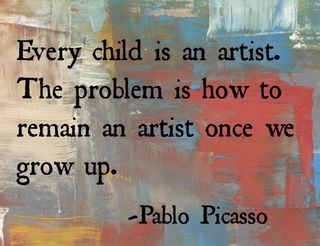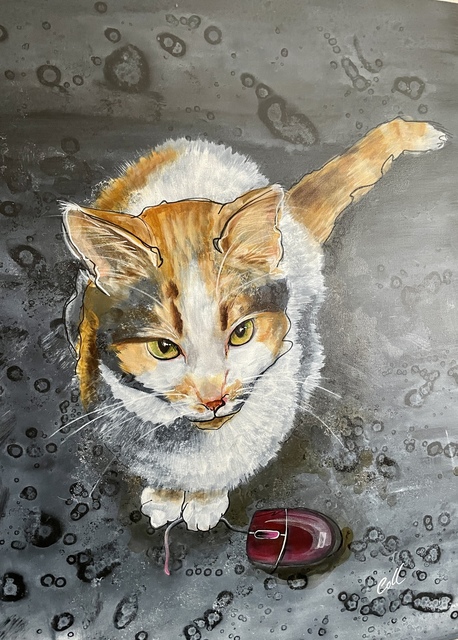Who is Pablo Picasso
Ah, the enigmatic and captivating Mr Picasso, my all-time favourite artist. Let me share my own personal journey of discovery with you, delving into the intriguing world of this artistic genius.
Instead of providing a mundane historical account, which you can easily find on countless websites and in books, I will paint a vivid picture of my own experience.
It all began during my teenage years when I dabbled in creating pleasant, picturesque scenes at a night school art class. It was there that I encountered Picasso's artwork for the first time. As fate would have it, a fellow artist, who happened to be absent from our class, dismissed our work as mere "chocolate-box covers" and encouraged us to explore the realm of real art. Intrigued, I decided to heed their advice.
At first, I have to admit, that Picasso's creations did not resonate with me. I found them peculiar, even childlike and struggled to comprehend their essence.
It wasn't until my early twenties, when my interest in art deepened that I yearned for more than just capturing the scenes before me. Instead, I sought to stay within the boundaries of traditional art, craving a challenge that would ignite my mind and push me beyond the confines of realism.
I embarked on a journey of studying abstract and contemporary artists, and it was during this quest that Picasso's cubist style seized my attention. As a pioneer in this avant-garde movement, his works resurfaced in my exploration.
Pieces that once appeared wild and perplexing suddenly burst forth with life as if awakening from a deep sleep. In that transformative moment, I grasped their profound meaning and understood the profound messages Picasso was trying to convey.
So you see, my perception of Picasso's art underwent a remarkable transformation. What I initially deemed strange and incomprehensible evolved into a realm of artistic expression that challenged and captivated my imagination. Picasso became my guide in pushing the boundaries of creativity, inspiring me to think beyond the conventional and urging me to embark on a quest for a deeper artistic understanding.
A famous quote of Picasso’s is

Picasso, a visionary artist, held a profound belief that children possessed the key to creating extraordinary works of art. He found beauty in simplicity, a concept that reverberates throughout his art. The sheer popularity and immense value of his pieces, which continue to fetch millions even today, attest to the undeniable impact of his talent. So who are we to judge the quality of his work when it has received so much acclaim?
In attempting to summarise Picasso's art, his own words best sum up his unique perspective: "Are we to paint what's on the face, what's inside the face, or what's behind it?" This quote sheds light on the abundance of ears, eyes, noses, and other features that populate his artwork. It challenges us to question why the back of someone's head can be just as captivating as the front. Picasso's response was to embrace it all and incorporate it into his compositions.
Recently, I had the opportunity to reproduce a copy of Picasso's monumental masterpiece, "Guernica", incorporating my own take on life during the covid pandemic of 2020. (Pictured below).
This awe-inspiring depiction of the bombing of Guernica in 1937 during the Spanish Civil War showcased the profound influence of Picasso on my artistic endeavours. While I strive to maintain my style and direction, it's impossible to deny the lasting impact of his work.
I also indulged in creating a replica of one of Picasso's paintings, "Girl Before a Mirror." I undertook this project for the bi-annual Fakes and Forgeries exhibition held in Mangaweka, New Zealand 2009. However, my intention extended beyond participating in the show; I sought to possess a 'genuine Picasso,' not a mere print, but a painting bearing my signature. You can find my rendition of this precious artwork below.

It takes pride of place in my own collection of artworks, alongside artworks by fellow artists.
I also named my cat after him. Sadly he is no longer here, but my feline companion, Picasso, often lent a paw (or a pawful of mischief) when I painted. Although his involvement typically resulted in colourful pawprints on the carpet or floor, he exudes a keen interest in being surrounded by paint and napping amidst the canvases. I even created a painting titled "Mousecatcher," shown below, featuring my beloved Picasso as the subject. Picasso, the cat, appeared in many of my artworks during his 13 years lifetime.

So, let us celebrate the enduring legacy of this artistic luminary and revel in the remarkable connection his work evokes within us. Picasso's ability to tap into the essence of art, embrace the unconventional and challenge our perceptions continues to inspire countless individuals, including myself, on our creative journeys.
Here are a Few Interesting Facts-
Pablo Ruiz Picasso
His full name was….wait for it……Pablo Diego José Francisco de Paula Juan Nepomuceno María de los Remedios Cipriano de la Santísima Trinidad Clito Ruiz y Picasso
He was born on the 25th October, 1881 in
His father Jose Ruiz y Blasco was a painter and a professor of art at the
In 1900 Picasso went to Paris for the first time, times were hard while living there and Picasso and he was forced to burn many of his paintings just to keep himself warm. I cringe at the thought.
All the paintings by Pablo Picasso are usually classified into various ‘periods’ based on the moods and styles of the paintings. These, in turn, were largely affected by his personal and love life.
His real work and career as a painter is said to begin around 1894 with a painting called ‘The First Communion’.
Most of his art career was split into various ‘periods like the Blue Period, the Rose Period, Analytic Cubism Period and his African Influenced Period for example, these were said to be influenced by his moods along with the styles of the artwork.
1909 to 1912 is called Picasso’s Analytic Cubism Period. This style of painting was developed along with Georges Braque and was characterized by the use of monochrome brown colours. He took the objects apart and analysed them within the medium of his paintings.
His love life was of great fascination to his fans, starting with Fernande Olivier in 1904, who appears in some of his Rose Period Paintings. Picasso left her for Marcelle Humbert, who he used to call Eva, and declarations of his love for her are seen in his Cubist paintings.
In 1918, Picasso married Olga Khokhlova who was a ballerina in Sergei Diaghilev’s troupe. Picasso was designing a ballet for him called ‘Parade’ in
Her socialising and Picasso’s bohemian lifestyle clashed often and their marriage was not successful. They separated when Picasso began a secret affair with 17 year old Marie-Therese Walter. Since the French Law required that Picasso give half of his property to Khokhlova upon divorcing her, and since Picasso did not want her to have half of his wealth, they never divorced, but remained separated till she died in 1955.
I recently read a book written by his grand-daughter (Paulo’s second child.) where she talked about her relationship with her grandfather which was fraught with conflict and isolation from him. She ended up being the main heir to his fortune and still runs the empire to this day.
Picasso continued his affair with Maria-Therese for a long time, and even had a daughter called Maia with her. She lived in the hope that he would marry her some day, which Picasso never did. Four years after Picasso’s death, Maria-Therese hung herself.
Photographer and painter Dora Maar was also a constant companion and a lover of Picasso during the 1930s and early 1940s. She even documented the painting of the ‘
In 1944, Picasso began an affair with a young art student called Francoise Gilot. They had two children, Claude and Paloma. She was the first woman in Picasso’s life who left him because of his many infidelities. This was in 1953. Picasso was greatly disturbed by this. He was in his 70s now and began to see his old age from a very depressing point of view.
He had a six week long affair with a beautiful and young girl called Genevieve Laporte, probably on the rebound.
Then he met Jacqueline Roque who worked at Madoura Pottery where Picasso made and painted ceramic art. They were together till Picasso’s death. They married in 1961 so that Picasso could take revenge on Gilot.
Gilot, with Picasso’s encouragement, filed divorce with her husband and then was going to marry Picasso in order to legitimize the status of her two children and secure their rights. But when Gilot filed the divorce papers, he went ahead and secretly married Roque to foil her attempts and thus got revenge for her leaving him.
Pablo Picasso died on
‘Drink to me, drink to my health, you know I can’t drink anymore.’
Posted: Tuesday 2 February 2010

